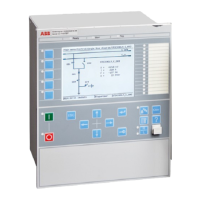Load
T1
I
L
T2
U
B
U
L
I
T1
I
T2
en06000486.vsd
IEC06000486 V1 EN-US
Figure 155: Parallel transformers with equal rated data.
In the reverse reactance method, the line voltage drop compensation is used. The original of
the line voltage drop compensation function purpose is to control the voltage at a load point
further out in the network. The very same function can also be used here to control the voltage
at a load point inside the transformer, by choosing a negative value of the parameter
Xline
.
Figure 156, shows a vector diagram where the principle of reverse reactance has been
introduced for the transformers in figure 155. The transformers are here supposed to be on
the same tap position, and the busbar voltage is supposed to give a calculated compensated
value U
L
that coincides with the target voltage
USet
.
IEC06000485_2_en.vsd
UB
RLIT1=RLIT2
jXLIT1=jXLIT2
IT1=IT2=(IT1+IT2)/2
U
L
1
=
U
L
2
=
U
S
e
t
IEC06000485 V3 EN-US
Figure 156: Vector diagram for two transformers regulated exactly on target voltage.
A comparison with figure 153 gives that the line voltage drop compensation for the purpose of
reverse reactance control is made with a value with opposite sign on X
L
, hence the designation
“reverse reactance” or “negative reactance”. Effectively this means that, whereas the line
voltage drop compensation in figure
153 gave a voltage drop along a line from the busbar
voltage U
B
to a load point voltage U
L
, the line voltage drop compensation in figure 156 gives a
voltage increase (actually, by adjusting the ratio X
L
/R
L
with respect to the power factor, the
length of the vector U
L
will be approximately equal to the length of U
B
) from U
B
up towards the
transformer itself. Thus in principal the difference between the vector diagrams in figure
153
and figure 156 is the sign of the setting parameter X
L
.
Section 13 1MRK 511 358-UEN A
Control
306
Application manual

